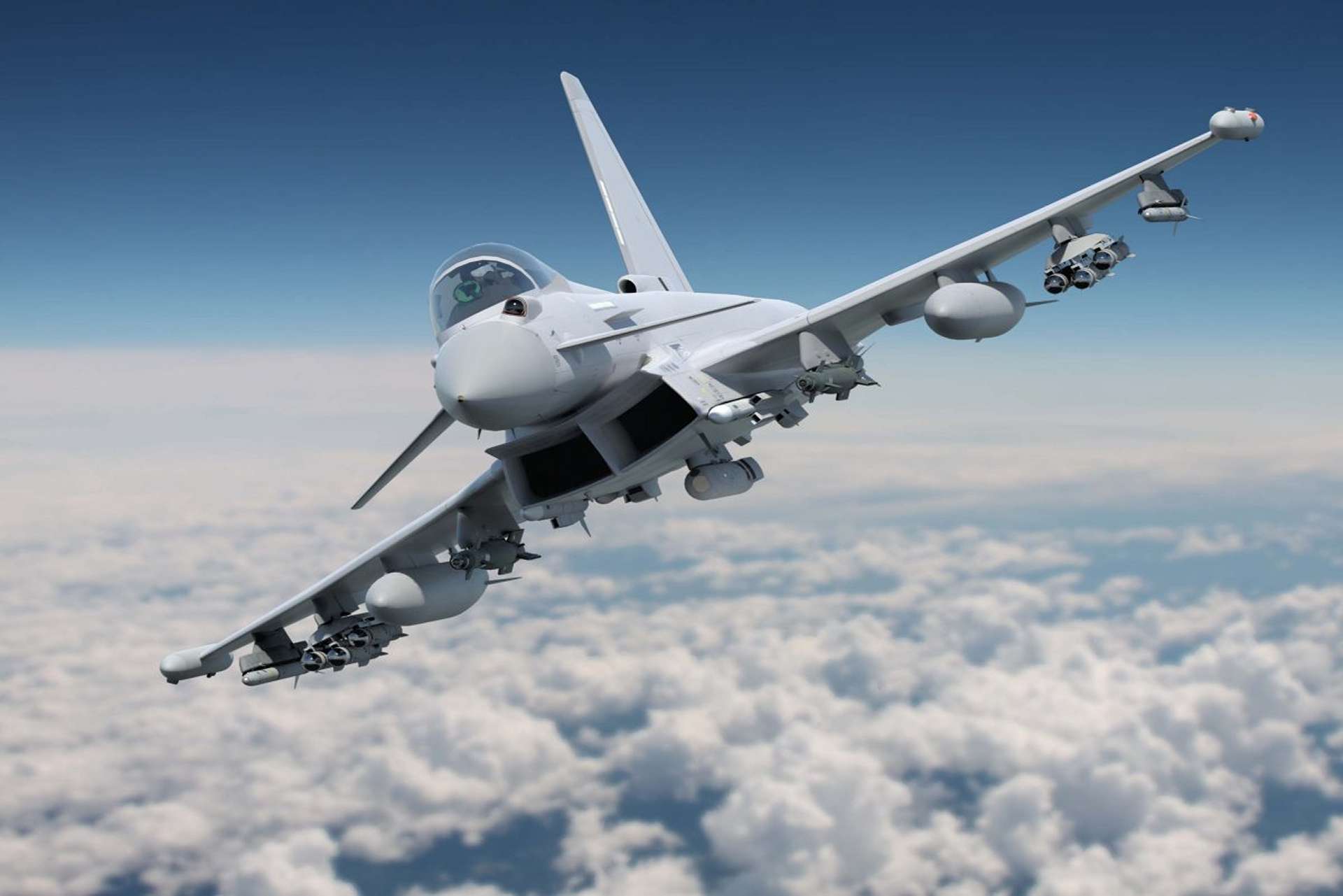Italy to Acquire New Squadron of Eurofighter Typhoon Multirole Fighter Jets

{loadposition bannertop}
{loadposition sidebarpub}
On May 14, 2024, Gareth Jennings, the Aviation Desk Editor at Jane’s, reported that a BAE Systems spokesperson confirmed earlier speculations regarding the expansion of the Italian Air Force’s Eurofighter Typhoon fleet. Italy is reportedly considering the addition of 24 more Typhoon multirole fighters to its fleet. Follow Army Recognition on Google News at this link
BAE System Eurofighter Typhoon Multirole Fighter(Picture source: BAE Systems)
The purpose is to replace the 28 Tranche 1 aircraft, deemed less capable than those of Tranches 2 and 3A. The new Eurofighters will be similar to those of Tranche 4+ or even the anticipated Tranche 5, envisioned by Spain’s Halcon II program. Tranche 4+ notably introduces the European Common Radar System Mark 1 (ECRS Mk1), an Active Electronically Scanned Array (AESA) radar, while Tranche 5 will add even more sophisticated elements with components from the Long-Term Evolution (LTE) package.
The LTE includes several enhancements: upgrades to the Eurojet EJ200 engine, a revised mission system architecture, advanced defensive aids, a modernized cockpit with a large touchscreen, and new adaptive power and cooling technologies. These improvements will allow the integration of high-tech armaments, enhance connectivity, and bring structural changes that will increase the aircraft’s aerodynamics and maneuverability.
Popularly known as the Typhoon, this multi-role combat aircraft was first introduced by the Italian Air Force as the F-2000A (or TF-2000A for the two-seater) at RIAT in 2013 and was showcased again in 2019. With a length of approximately 15.96 meters, a wingspan of 10.95 meters, and a height of 5.28 meters, the Typhoon is noted for its great agility and performance in various combat scenarios.
The propulsion system of the Eurofighter Typhoon includes two Eurojet EJ200 turbofan engines, each capable of producing a thrust of 20,000 pounds-force with afterburner, enabling the aircraft to reach a maximum speed of Mach 2. The advanced technical features of the aircraft include modern avionics, a highly optimized aerodynamic frame, and a sophisticated flight control system. The cutting-edge avionics of the Eurofighter Typhoon include the Captor-E AESA radar, an advanced electronic warfare system, a helmet-mounted display, and a comprehensive suite of sensors and communication systems, thus enhancing its combat effectiveness.
Over the past 20 years, the Italian Air Force, which currently operates 94 Eurofighter Typhoons, has achieved more than 80,000 flight hours with this type of aircraft. The multirole fighter now equips six squadrons (9°, 10°, 12°, 18°, 20°, and 132° Gruppo) located at four bases: Grosseto, Gioia del Colle, Trapani, and Istrana. The Typhoons provide round-the-clock Quick Reaction Alert (QRA) service both domestically and internationally and are regularly deployed to carry out a variety of roles, including missions exceeding 8 hours in support of the anti-Daesh coalition in Iraq and Syria.
The Eurofighter Typhoon is a multi-role combat aircraft developed by a consortium of European aerospace companies, including Airbus, BAE Systems, and Leonardo. Designed for a wide range of air operations, the Typhoon features a delta wing and canard configuration, providing significant maneuverability. The aircraft is intended to meet both current and future operational needs, with continuous upgrades keeping it updated with combat aviation technology. It has a maximum takeoff weight of 23,500 kg and a maximum speed of Mach 2.0.
Powered by two Eurojet EJ200 afterburning turbofan engines, each providing 60 kN (13,000 lbf) of thrust dry and 90 kN (20,000 lbf) with an afterburner, the Eurofighter Typhoon can reach a maximum speed of 2,125 km/h or Mach 2.35 at high altitude and 1,530 km/h or Mach 1.25 at sea level. It has a supercruise capability at Mach 1.5, a maximum range of 2,900 kilometers, and a service ceiling of 19,812 meters (65,000 feet).
The Typhoon’s armament includes a 27 mm Mauser BK-27 revolver cannon with 150 rounds and 13 hardpoints (8 under-wing and 5 under-fuselage) capable of carrying over 9,000 kg of payload. In air-to-air combat, the Eurofighter Typhoon can climb at a rate of 315 meters per second (62,000 feet per minute). It is equipped with advanced radar and targeting systems, including the Captor-E AESA radar, capable of tracking up to 20 targets simultaneously and engaging them with precision. Its armament includes air-to-air missiles such as the AIM-120 AMRAAM, MBDA Meteor, IRIS-T, AIM-132 ASRAAM, and AIM-9 Sidewinder for beyond-visual-range (BVR) engagement.
The Eurofighter Typhoon also performs well in air-to-ground missions. It can carry precision-guided munitions, including Paveway IV laser-guided bombs, Storm Shadow cruise missiles, Brimstone anti-tank missiles, Taurus air-to-surface missiles, and AGM-88 HARM anti-radiation missiles. Its targeting pod, the LITENING III, allows for accurate identification and engagement of ground targets under various weather conditions. This capability supports roles such as close air support, interdiction, and strategic strike missions. Furthermore, the Typhoon can also carry anti-ship missiles such as the Marte ER and the Joint Strike Missile (JSM).
The aircraft’s avionics and electronic warfare systems are advanced. The Defensive Aids Sub System (DASS) offers protection against threats such as radar-guided and infrared-guided missiles. It includes communication and data link systems like Link 16 for integration with other air and ground assets, enhancing situational awareness and coordination in complex environments. Additionally, the Typhoon is equipped with an Infra-Red Search and Track (IRST) system for passive target detection.
Ongoing upgrades and modernization programs help maintain the Eurofighter Typhoon’s operational effectiveness. Recent enhancements include the Phase 4 Enhancement (P4E) package, which integrates the new ECRS Mk2 AESA radar to improve electronic warfare and attack capabilities. This radar can detect, identify, and track multiple targets in the air and on the ground simultaneously. The Praetorian Defensive Aids Sub-System (DASS) is also being upgraded to enhance survivability against modern threats, including infrared and radar-guided missiles, through initiatives such as the Praetorian eVolution roadmap.

{loadposition bannertop}
{loadposition sidebarpub}
On May 14, 2024, Gareth Jennings, the Aviation Desk Editor at Jane’s, reported that a BAE Systems spokesperson confirmed earlier speculations regarding the expansion of the Italian Air Force’s Eurofighter Typhoon fleet. Italy is reportedly considering the addition of 24 more Typhoon multirole fighters to its fleet.
Follow Army Recognition on Google News at this link
BAE System Eurofighter Typhoon Multirole Fighter
(Picture source: BAE Systems)
The purpose is to replace the 28 Tranche 1 aircraft, deemed less capable than those of Tranches 2 and 3A. The new Eurofighters will be similar to those of Tranche 4+ or even the anticipated Tranche 5, envisioned by Spain’s Halcon II program. Tranche 4+ notably introduces the European Common Radar System Mark 1 (ECRS Mk1), an Active Electronically Scanned Array (AESA) radar, while Tranche 5 will add even more sophisticated elements with components from the Long-Term Evolution (LTE) package.
The LTE includes several enhancements: upgrades to the Eurojet EJ200 engine, a revised mission system architecture, advanced defensive aids, a modernized cockpit with a large touchscreen, and new adaptive power and cooling technologies. These improvements will allow the integration of high-tech armaments, enhance connectivity, and bring structural changes that will increase the aircraft’s aerodynamics and maneuverability.
Popularly known as the Typhoon, this multi-role combat aircraft was first introduced by the Italian Air Force as the F-2000A (or TF-2000A for the two-seater) at RIAT in 2013 and was showcased again in 2019. With a length of approximately 15.96 meters, a wingspan of 10.95 meters, and a height of 5.28 meters, the Typhoon is noted for its great agility and performance in various combat scenarios.
The propulsion system of the Eurofighter Typhoon includes two Eurojet EJ200 turbofan engines, each capable of producing a thrust of 20,000 pounds-force with afterburner, enabling the aircraft to reach a maximum speed of Mach 2. The advanced technical features of the aircraft include modern avionics, a highly optimized aerodynamic frame, and a sophisticated flight control system. The cutting-edge avionics of the Eurofighter Typhoon include the Captor-E AESA radar, an advanced electronic warfare system, a helmet-mounted display, and a comprehensive suite of sensors and communication systems, thus enhancing its combat effectiveness.
Over the past 20 years, the Italian Air Force, which currently operates 94 Eurofighter Typhoons, has achieved more than 80,000 flight hours with this type of aircraft. The multirole fighter now equips six squadrons (9°, 10°, 12°, 18°, 20°, and 132° Gruppo) located at four bases: Grosseto, Gioia del Colle, Trapani, and Istrana. The Typhoons provide round-the-clock Quick Reaction Alert (QRA) service both domestically and internationally and are regularly deployed to carry out a variety of roles, including missions exceeding 8 hours in support of the anti-Daesh coalition in Iraq and Syria.
The Eurofighter Typhoon is a multi-role combat aircraft developed by a consortium of European aerospace companies, including Airbus, BAE Systems, and Leonardo. Designed for a wide range of air operations, the Typhoon features a delta wing and canard configuration, providing significant maneuverability. The aircraft is intended to meet both current and future operational needs, with continuous upgrades keeping it updated with combat aviation technology. It has a maximum takeoff weight of 23,500 kg and a maximum speed of Mach 2.0.
Powered by two Eurojet EJ200 afterburning turbofan engines, each providing 60 kN (13,000 lbf) of thrust dry and 90 kN (20,000 lbf) with an afterburner, the Eurofighter Typhoon can reach a maximum speed of 2,125 km/h or Mach 2.35 at high altitude and 1,530 km/h or Mach 1.25 at sea level. It has a supercruise capability at Mach 1.5, a maximum range of 2,900 kilometers, and a service ceiling of 19,812 meters (65,000 feet).
The Typhoon’s armament includes a 27 mm Mauser BK-27 revolver cannon with 150 rounds and 13 hardpoints (8 under-wing and 5 under-fuselage) capable of carrying over 9,000 kg of payload. In air-to-air combat, the Eurofighter Typhoon can climb at a rate of 315 meters per second (62,000 feet per minute). It is equipped with advanced radar and targeting systems, including the Captor-E AESA radar, capable of tracking up to 20 targets simultaneously and engaging them with precision. Its armament includes air-to-air missiles such as the AIM-120 AMRAAM, MBDA Meteor, IRIS-T, AIM-132 ASRAAM, and AIM-9 Sidewinder for beyond-visual-range (BVR) engagement.
The Eurofighter Typhoon also performs well in air-to-ground missions. It can carry precision-guided munitions, including Paveway IV laser-guided bombs, Storm Shadow cruise missiles, Brimstone anti-tank missiles, Taurus air-to-surface missiles, and AGM-88 HARM anti-radiation missiles. Its targeting pod, the LITENING III, allows for accurate identification and engagement of ground targets under various weather conditions. This capability supports roles such as close air support, interdiction, and strategic strike missions. Furthermore, the Typhoon can also carry anti-ship missiles such as the Marte ER and the Joint Strike Missile (JSM).
The aircraft’s avionics and electronic warfare systems are advanced. The Defensive Aids Sub System (DASS) offers protection against threats such as radar-guided and infrared-guided missiles. It includes communication and data link systems like Link 16 for integration with other air and ground assets, enhancing situational awareness and coordination in complex environments. Additionally, the Typhoon is equipped with an Infra-Red Search and Track (IRST) system for passive target detection.
Ongoing upgrades and modernization programs help maintain the Eurofighter Typhoon’s operational effectiveness. Recent enhancements include the Phase 4 Enhancement (P4E) package, which integrates the new ECRS Mk2 AESA radar to improve electronic warfare and attack capabilities. This radar can detect, identify, and track multiple targets in the air and on the ground simultaneously. The Praetorian Defensive Aids Sub-System (DASS) is also being upgraded to enhance survivability against modern threats, including infrared and radar-guided missiles, through initiatives such as the Praetorian eVolution roadmap.





